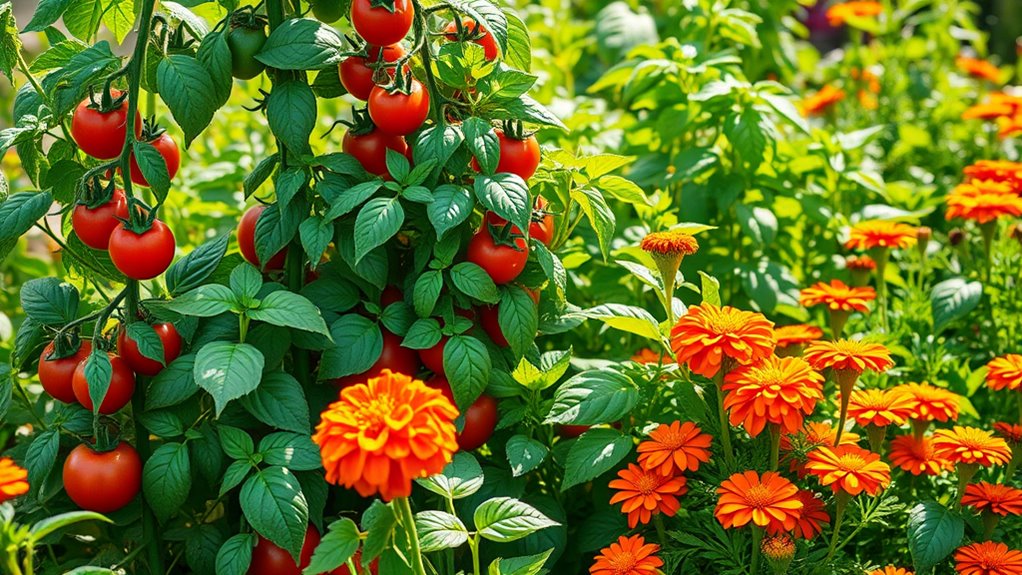Want More Veggies. Try This Companion Planting Strategy
Want more veggies? Boost your harvest with companion planting, pairing plants to naturally deter pests and enrich soil. You’ll pair marigolds with tomatoes to ward off nematodes, or basil near onions to repel aphids and enhance flavors. Maximize space using trellises for climbers and intercropping tall with short plants. Select pest-resistant varieties and monitor regularly for ideal growth. Delve into these strategies to uncover even more garden wins ahead.
Benefits of Companion Planting
Companion planting boosts your garden’s productivity by strategically pairing plants that support each other.
When you practice companion planting vegetables, you’re naturally deterring pests, enhancing soil fertility, attracting beneficial insects, and promoting better pollination, which reduces diseases and maximizes yields. This scientific approach makes your garden more resilient, efficient, and environmentally friendly without added chemicals. Additionally, certain plant combinations can enhance each other’s growth, leading to a more vibrant and productive garden ecosystem.
Ideal Plant Pairings for Vegetables
As you plan your vegetable garden, you’ll find that selecting the best veggie pairs enhances growth and pest control through natural interactions.
You can choose ideal companion plants like marigolds with tomatoes to deter nematodes effectively. Additionally, incorporating companion planting techniques can lead to healthier plants and improved yields.
Now, explore these effective plant combos to maximize your yields with science-backed strategies.
Best Veggie Pairs
When selecting the best veggie pairs, you’ll maximize your garden’s productivity by choosing combinations that deter pests, enrich soil, and boost growth.
For instance, plants with deep roots aerate soil for shallow-rooted veggies, while aromatic herbs repel insects naturally.
Scientifically, these pairings leverage allelopathy and nutrient sharing for maximum yields, making your setup efficient and sustainable.
Always observe local conditions for best results.
Ideal Companion Choices
How do you select ideal companions for your vegetables?
You’ll focus on practical, scientific criteria like compatibility in resources and growth to foster a healthy garden.
- Evaluate soil pH and nutrient needs to guarantee plants don’t compete, promoting balanced uptake.
- Assess pest-repelling traits so companions naturally protect your veggies from common insects.
- Match water and sunlight requirements for harmonious growth without stressing plants.
- Consider growth habits like height and spacing to avoid shading or overcrowding issues.
Effective Plant Combos
Now that you’ve evaluated key criteria for companion plants, specific pairings can maximize your garden’s productivity.
For effective results, try basil near tomatoes to ward off pests and boost flavors.
Plant onions with carrots to repel aphids and increase production.
Use marigolds around beans to fight soil nematodes and promote strong growth.
These combos, supported by research, enhance your garden’s efficiency.
Maximizing Space With Strategic Layouts
To maximize your garden’s space, you’ll use vertical garden techniques like trellises and wall planters to grow upwards and free up ground area.
Next, intercropping space strategies let you plant complementary veggies together in the same bed, boosting yields without overcrowding.
Finally, layered layout designs position tall, medium, and short plants at different levels for efficient light use and easier harvesting. Additionally, effective companion planting can help enhance crop yields and promote healthier garden ecosystems.
Vertical Garden Techniques
Vertical garden techniques enable you to maximize limited space in your vegetable plots through smart, layered layouts that support companion planting and boost yields.
To get started, consider these techniques:
- Install trellises for climbing veggies like beans, freeing ground for shorter plants.
- Use hanging baskets to grow trailing species, optimizing upward space.
- Stack modular planters in tiers, allowing multi-level crop arrangements.
- Attach wall-mounted systems for compact greens, enhancing overall efficiency.
Intercropping Space Strategies
While vertical gardens reach skyward, intercropping lets you squeeze more from your horizontal plots by strategically mixing crops that thrive together, boosting yields and minimizing waste.
To optimize space, pair tall plants with low-growers, like corn and beans, for mutual support.
You’ll rotate crops to prevent soil depletion, ensuring each variety accesses sunlight and nutrients efficiently, maximizing your harvest potential.
Layered Layout Designs
Layered layout designs build on intercropping by stacking plants in vertical tiers to amplify your garden’s efficiency.
This method helps you maximize space while promoting biodiversity and resource use.
-
Select tall plants like corn for the upper layer to capture more sunlight.
-
Add medium-height crops such as beans in the middle for balanced growth.
-
Place low-growing veggies like lettuce at the base to cover soil.
-
Monitor water and nutrients for each tier to achieve healthy yields.
Natural Pest Control Techniques
Companion planting offers effective ways to manage pests naturally in your vegetable garden.
You’ll deter insects by pairing repellent plants like marigolds with susceptible crops, as they release compounds that disrupt pest behavior.
For instance, interplanting basil near tomatoes attracts beneficial predators that control aphids, reducing infestations.
This practical approach boosts biodiversity, minimizes damage, and maintains a balanced ecosystem without chemicals. Additionally, implementing natural barriers such as copper tape or diatomaceous earth can further deter unwanted pests like slugs.
Selecting and Preparing Your Plants
After building on natural pest control with companion planting, you select plants that suit your garden’s conditions and prepare them for ideal growth.
When choosing, consider soil pH, sunlight, and water needs; for preparation, focus on germination and hardening.
-
Test your soil’s pH and nutrients to match plant requirements.
-
Choose pest-resistant varieties based on local climate data.
-
Soak or stratify seeds to boost germination success.
-
Gradually harden off seedlings for better adaptation. Additionally, be aware of common companion planting mistakes to ensure successful pairings that enhance growth and deter pests.
Tips for Successful Implementation
How can you guarantee your companion planting thrives in your garden?
Select plant pairs based on scientific studies for mutual benefits like pest repulsion.
Test and amend soil pH as needed.
Space plants appropriately to minimize competition for nutrients.
Water consistently and use organic mulches for moisture retention.
Monitor pests regularly and rotate crops annually to sustain soil health.
Keep detailed records for adjustments.

